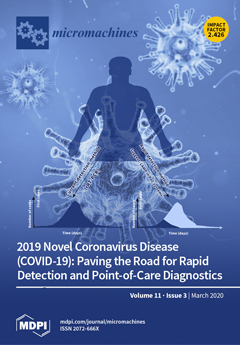Tungsten trioxide (WO
3) is a wide band gap semiconductor material, which is commonly not only used, but also investigated as a significant electrochromic layer in electrochromic devices. WO
3 films have been prepared by inorganic and sol-gel free ammonium tungstate ((NH
[...] Read more.
Tungsten trioxide (WO
3) is a wide band gap semiconductor material, which is commonly not only used, but also investigated as a significant electrochromic layer in electrochromic devices. WO
3 films have been prepared by inorganic and sol-gel free ammonium tungstate ((NH
4)
2WO
4), with the modification of glycerol using the spin coating technique. The surface tension, the contact angle and the dynamic viscosity of the precursor solutions demonstrated that the sample solution with a 25% volume fraction of glycerol was optimal, which was equipped to facilitate the growth of WO
3 films. The thermal gravimetric and differential scanning calorimetry (TG-DSC) analysis represented that the optimal sample solution transformed into the WO
3 range from 220 °C to 300 °C, and the transformation of the phase structure of WO
3 was taken above 300 °C. Fourier transform infrared spectroscopy (FT-IR) spectra analysis indicated that the composition within the film was WO
3 above the 300 °C annealing temperature, and the component content of WO
3 was increased with the increase in the annealing temperature. The X-ray diffraction (XRD) pattern revealed that WO
3 films were available for the formation of the cubic and monoclinic crystal structure at 400 °C, and were preferential for growing monoclinic WO
3 when annealed at 500 °C. Atomic force microscope (AFM) images showed that WO
3 films prepared using ammonium tungstate with modification of the glycerol possessed less rough surface roughness in comparison with the sol-gel-prepared films. An ultraviolet spectrophotometer (UV) demonstrated that the sample solution which had been annealed at 400 °C obtained a high electrochromic modulation ability roughly 40% at 700 nm wavelength, as well as the optical band gap (E
g) of the WO
3 films ranged from 3.48 eV to 3.37 eV with the annealing temperature increasing.
Full article






